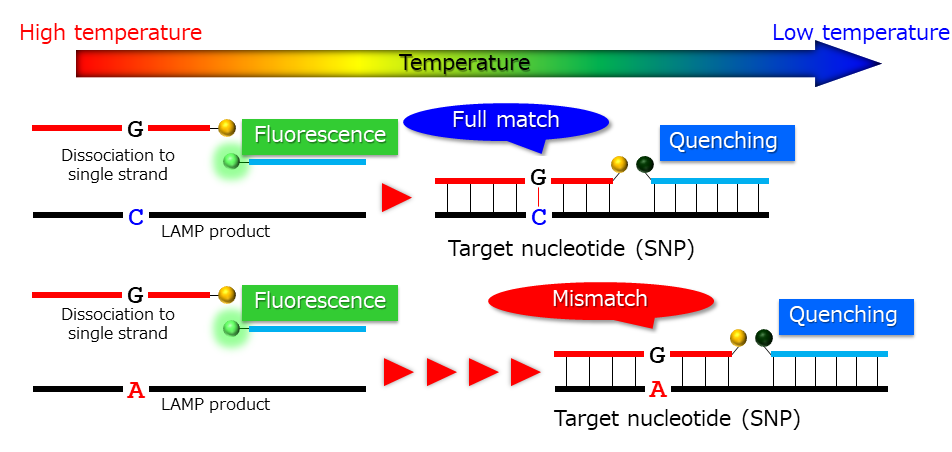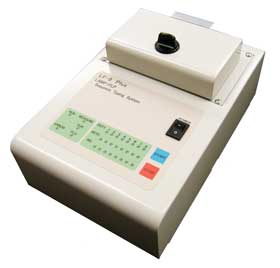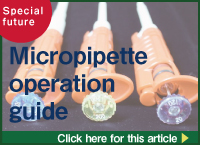What is the LAMP-FLP method?
What is the LAMP-FLP method?

The LAMP-FLP method, which won the Minister of Education, Culture, Sports, Science and Technology Award at the Chubu Regional Invention Award in FY2020, is a technology expected to be used in various fields such as medical practice and agriculture. Here we would like to explain in as easy a way as possible how gene polymorphism analysis can be performed.
1:Single nucleotide polymorphisms (SNPs)
DNA is said to be a blueprint for making the body of an organism.
This DNA is composed of four types of bases: adenine (A), guanine (G), cytosine (C), and thymine (T). In humans, 3 billion bases of information are stored in a single cell as a blueprint.
The information in this blueprint, differs slightly from person to person, and this also affects differences in one’s constitution such as tolerance against alcohol.
After drinking, the alcohol is metabolized to acetaldehyde, which is a harmful substance that causes sickness, by the action of enzymes in the body. Aldehyde dehydrogenase-2 (ALDH2) is also used to degrade the acetaldehyde.
When a specific part of the sequence of the ALDH2 gene is replaced from G (guanine) to A (adenine), acetaldehyde cannot be degraded. If it is the case, you have a constitution vulnerable to alcohol.
The replacement of a single nucleotide sequence by alternate nucleotide is called a single nucleotide polymorphism (SNP). The polymorphism also occurs in various other genes.
Since this single nucleotide polymorphism (SNP) is also related to its efficacy in medicine, tailor-made medicine and other medicine have been conducted to provide medicine tailored to the individual’s constitution in recent years.
Single nucleotide polymorphisms (SNPs) are also present in bacteria and others, and the existence of plant disease-causing bacteria that are resistant to pesticides, which are associated with mutation, is now becoming a problem in the agricultural field.
The LAMP-FLP method, which we developed, is a technology that can quickly and easily detect differences in the properties of organisms due to single nucleotide polymorphisms (SNPs), and is expected to be active in various fields such as clinical practice and agriculture.
So, here we would like to present how the LAMP-FLP method detects single nucleotide polymorphisms (SNPs).
2:Principle of the LAMP-FLP Method
The LAMP-FLP method detects single nucleotide polymorphisms (SNPs) by DNA amplification (step 1) using the LAMP (Loop-mediated Isothermal Amplification) method and association curve analysis (step 2) using the fluorescence resonance energy transfer phenomenon.
<Step 1: DNA amplification>
In the LAMP-FLP method, the first step is to amplify DNA by the LAMP method.
The LAMP method is a DNA amplification method developed by Eiken Chemical Co., Ltd., and can amplify DNA exponentially by isothermal reaction using four (or six) types of primers and strand displacement type DNA polymerase.
It is key point for the LAMP-FLP method to design the probe and primers so that a DNA probe modified with a quencher substance is placed in a single nucleotide polymorphism (SNP) region, and a loop primer modified with a fluorescent substance is placed adjacent to the quencher substance. (Point 1)

When the quencher material and the fluorescent material are adjacent to each other as shown in the figure above, the quencher material quenches the fluorescent material.
<Step 2: Association Curve Analysis>
After DNA amplification by LAMP, the reaction temperature is raised to 98℃.
Usually double-stranded DNA is dissociated to single-stranded DNA at elevated temperatures. The DNA probe and the loop primer prepared in Step 1 are also dissociated, so that the fluorescent material quenched by the quencher material emits light.
When the temperature is lowered while monitoring this luminescence, the DNA probe and the loop primer bind to the double strand again, and the quencher material and the fluorescent material align next to each other, so that the fluorescent material is quenched again.
At this time, when the DNA probe is completely complementary to the single nucleotide polymorphism (SNP) region (full match), the fluorescent substance is quenched by binding to the complementary strand at a slightly higher temperature, whereas when the DNA probe has a sequence partially inconsistent with the complementary sequence of the single nucleotide polymorphism (SNP) region (mismatch), the fluorescent substance is quenched by binding to the complementary strand at a slightly lower temperature.
Analyzing the genotype of a single nucleotide polymorphism (SNP) by the difference in the temperature at which the fluorescent material quenches, is the second key point of the LAMP-FLP method. (Point 2)

A fine analysis of the correlation between the fluorescence intensity of the fluorescent substance and the temperature gradient shows the following melting curve analysis graph.

Each set of chromosomes is maternally and paternally derived, but if the single nucleotide polymorphism (SNP) region of either gene is completely complementary to the DNA probe (full match), the quenching peak appears as a “full match homozygous” only at a slightly higher temperature.
Conversely, if the single nucleotide polymorphism (SNP) region of any gene has a sequence that is partially mismatched with the DNA probe (mismatch), the peak of quenching appears as a “mismatch homozygous” only at a slightly lower temperature.
In addition, if the DNA probe is “heterozygous”, both full matched and mismatched against a single nucleotide polymorphism (SNP) region on chromosomes detected, two quenching peaks appear.
3:LAMP measuring instrument LF-8 Plus
In order to analyze single nucleotide polymorphisms (SNPs) by the LAMP-FLP method, a device capable of controlling the temperature and monitoring the fluorescent substances is required.
“LF-8 Plus” is a device that can perform a variety of measurements related to the LAMP method, including gene polymorphism analysis, turbidity measurement, gene amplification analysis using fluorescent substances, and reassociation curve analysis. It was originally developed as a genetic polymorphism analysis device using the LAMP-FLP method.

LF-8 Plus, a measuring instrument for the LAMP method
The LF-8 Plus is equipped with two types of sensors measuring turbidity and fluorescence. The turbidity sensor checks whether the LAMP-FLP method “Step 1: DNA amplification by LAMP method” successfully reacted (checks if the reaction solution is cloudy because the reaction solution becomes cloudy when DNA is amplified by the LAMP method).
In addition, the fluorescence sensor confirms the change in fluorescence intensity by “Step 2: Association Curve Analysis” of the LAMP-FLP method.
If you preset a program in the LF-8 Plus beforehand, you can easily analyze single nucleotide polymorphisms (SNPs) by simply pressing the start button.
See the following for related products and related articles.
Nippon Gene Co. Ltd. received the Minister of Education, Culture, Sports, Science and Technology Award at the Chubu Regional Invention AwardDNA Amplification Reagents Kit for LAMP-FLPLF-8 Plus, a measuring device for the LAMP method




